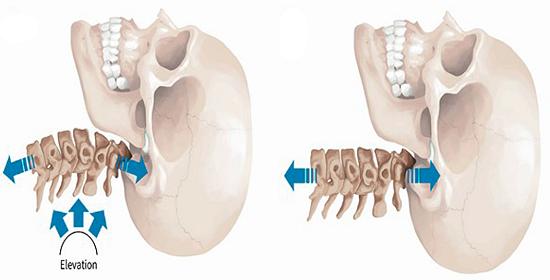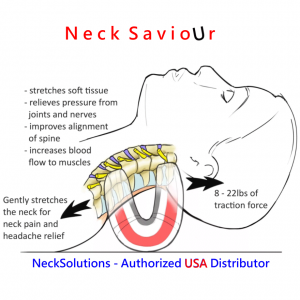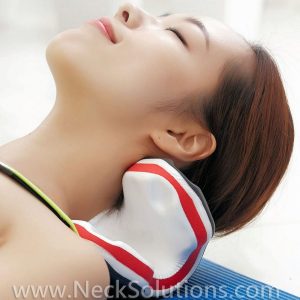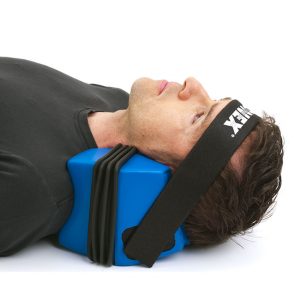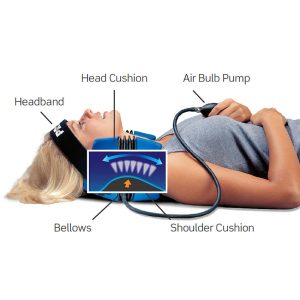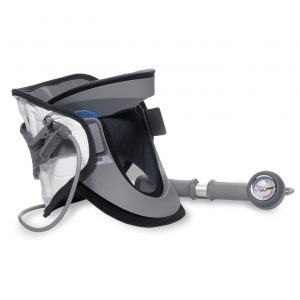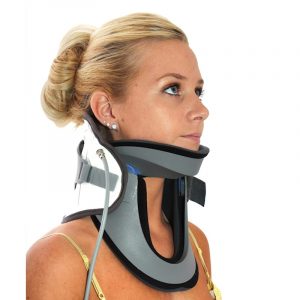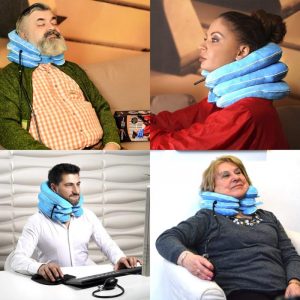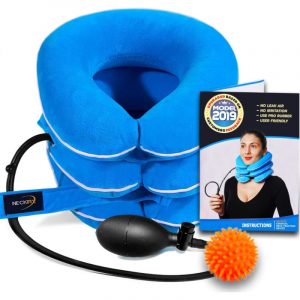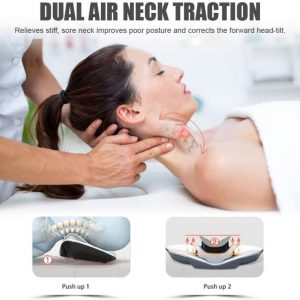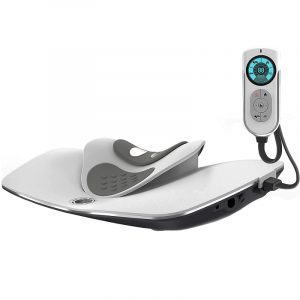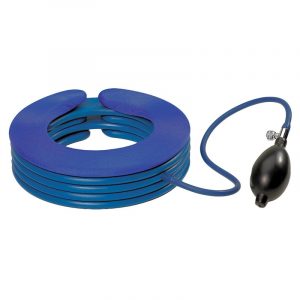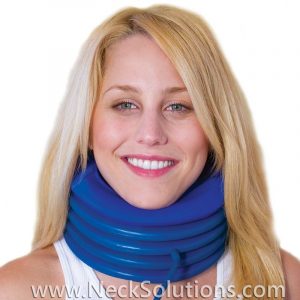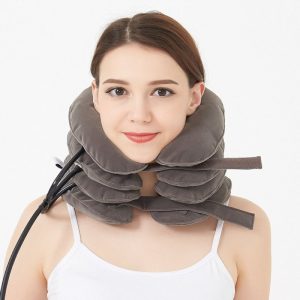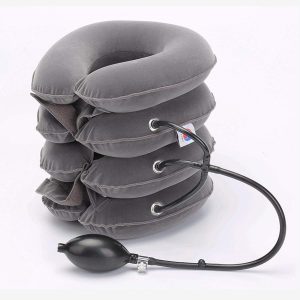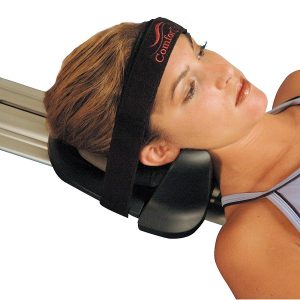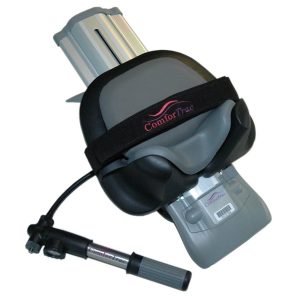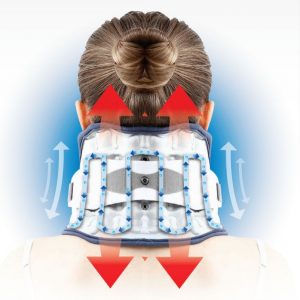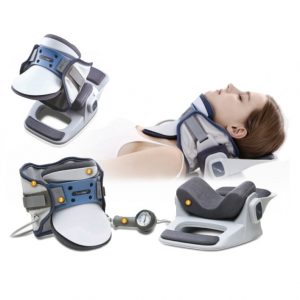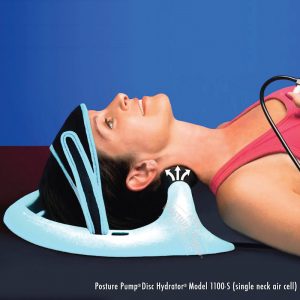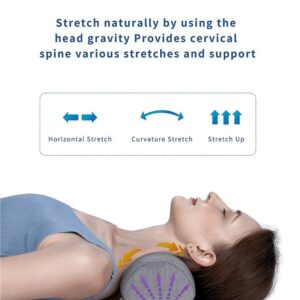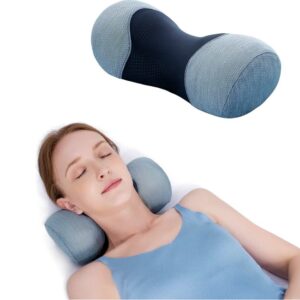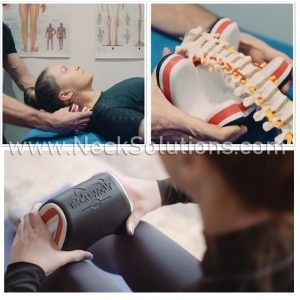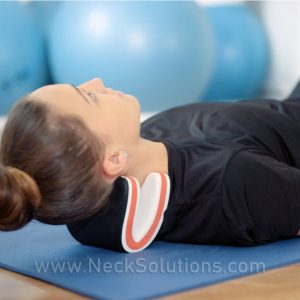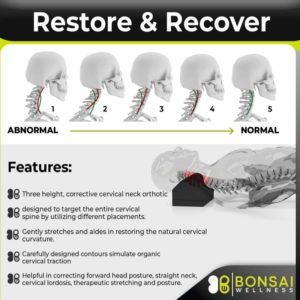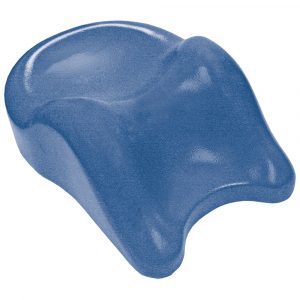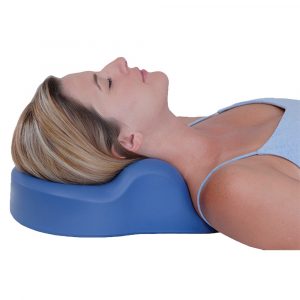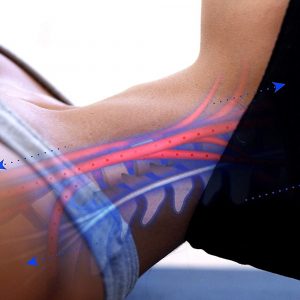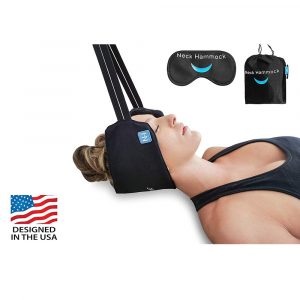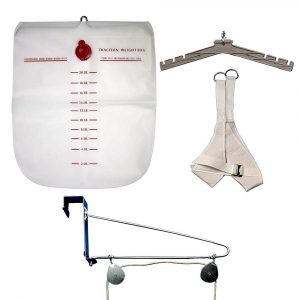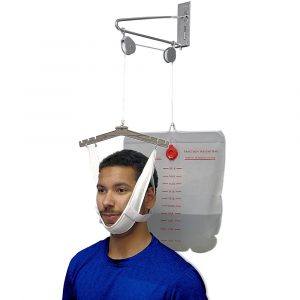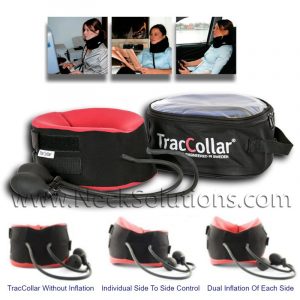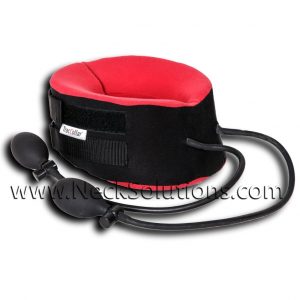Neck Traction Can Be An Effective Therapy For Neck Problems
Easily used at home, neck traction devices work to relieve stressful tension due to anxiety and trauma, impeding proper blood circulation and nerve function. As sensitive nerves and blood vessels become constricted by a pinching or squeezing effect, symptoms like neck pain, shoulder pain, tingling or numbness into the arm(s) or hand(s), and even headaches can result.
Relief Of Pain With Neck Traction
Neck traction can help with relief of pain, decrease pressure on nerves and ease muscle spasms. The newest neck stretcher devices can help increase blood circulation to the structures of the cervical spine, helping to oxygenate muscles, nerves, tendons as well as ligaments and this can increase energy, decrease pain while promoting relaxing via relief of constricting nerve and blood vessels, thus reducing pressure and tension. Increased muscle tension relates to constriction of blood vessels and nerves causing a release of inflammatory chemicals which create further irritation, tension and pain. Relieving this pressure may assist in alleviation of herniated/bulging discs and painful degenerative conditions like cervical osteoarthritis and/or facet syndrome of the joints.
- A 2017 cross sectional survey in the Journal of Orthopedic and Sports Physical Therapy indicated over 3/4 of therapists use cervical traction, with over 90% of respondents indicating they would use it for radiculopathy/pinched nerve symptoms. The use of traction to manage neck pain was higher (almost 90%) in those therapists with higher levels of education/orthopedic certifications than in those without.
These new home based devices are lightweight, easy to travel with and effective for neck pain relief.
Devices With Improved Comfort And Effectiveness
 For many years neck stretching devices have been used to obtain relief by removing nerve pressure and relaxing the tight muscles and improving the circulation. Until recently, many have been cumbersome and difficult to use at home. Many cervical traction devices employ a weighted system attached to the head and placing great amounts of pressure on the jaw.
For many years neck stretching devices have been used to obtain relief by removing nerve pressure and relaxing the tight muscles and improving the circulation. Until recently, many have been cumbersome and difficult to use at home. Many cervical traction devices employ a weighted system attached to the head and placing great amounts of pressure on the jaw.
They may utilize a harness that attaches with weights and allowed to place significant weight by hanging over the edge of a table or use a pulley system connected to a door with strings and a water bag. This may place harmful stress about the jaw, aggravating tmj pain in the jaw and may appear intimidating, instead of being a relaxing experience as well as being able to apply with ease and comfort. I have not had much luck getting patients to comply with these type of neck traction devices and I guess I don’t blame them. It’s just a bit scary for the average person.
Technological advances with newer methods and neck traction devices for home use are now easier to use, more comfortable, safer and more effective than door mounted devices. They range from general use by lifting the weight of the head off the neck while sitting, to more specific and effective methods used while lying on the back which can help to restore the natural neck posture.
Newer designing makes it easier to stretch and increase the length of muscles, while separating cervical joints, and this may induce effective relief related to discomfort and inflammation associated with many neck issues. Mild cervical traction may exercise neck muscles, improving blood circulation; where stronger traction forces decreases constriction of joints, taking pressure from pinched nerves and disc herniations. The air traction collars provide good traction force with great variability in sizing as well as comfortable and easy to use designs.
The Home Neck Traction unit is an effective means to restore correct posture if your neck is in fairly good condition, because it uses extension during therapy with a disc pumping action. It is important to know if there are any problems with extending your neck or tilting it back. Please review neck stretches to show how to test for extension. If this causes any dizziness or increase in pain then extension devices may not be the right ones for you. If there are no problems with extension or if it feels good, then either of these neck stretcher devices along with the neck exercises would be useful to aid in the restoration of the normal neck curve and posture. You must know that “normal” is relative and that the ideal configuration is not always the best for your particular condition.
Traction For Restoring The Proper Cervical Curve
Restoring the proper curve is an important part of helping neck pain. The loss of the normal curve leaves you 4 times more vulnerable to pain. Loss of this curve is promoted by poor neck postures resulting in a forward head posture or a military neck.
- A 2008 study in the journal Spine indicates loss of the neck curve can accelerate disc degeneration. The retrospective analysis used kinetic MRI to further recommend that restoring the normal curve should be considered to prevent degeneration and deterioration of symptoms. This is the goal for neck traction combined with extension in many of our products, but especially the home neck traction device.
Using Home Neck Traction
You may feel some discomfort initially, but that would not be uncommon. With continued and regular use along with the exercises illustrated at our complete source for neck exercises you can probably have noticeable correction of the cervical curve within approximately six months. Depending on your specific condition, it may take up to a year and in some cases complete correction is not possible. You do not always need to have complete correction for relief and, in some cases, it may not be desirable.
Correction of neck problems usually depends on the initial condition of your neck. Make sure you have a sleeping pillow with good support like a functional pillow so that you are not losing any gains you have made while you sleep and be very sure not to watch TV in bed unless you head is in the proper upright position by using ergonomic wedge pillows.
A great selection of devices provides relief at home. Choosing one depends on affordability, condition, preference and/or doctor recommendations or prescriptions. You can easily compare the units and we are glad to help you find individual solutions.
Traction For Cervical Spine Rehabilitation
 Cervical traction (stretching) is often employed to bring relief from compressed nerves and stiff muscles, however, it can also be used in rehabilitation from chronic conditions and injuries. With the new collar type traction devices, it is easy to perform exercises while using traction. The units can be inflated and resistance exercises can be performed to help increase strength of the neck muscles, which is a goal for rehabilitation
Cervical traction (stretching) is often employed to bring relief from compressed nerves and stiff muscles, however, it can also be used in rehabilitation from chronic conditions and injuries. With the new collar type traction devices, it is easy to perform exercises while using traction. The units can be inflated and resistance exercises can be performed to help increase strength of the neck muscles, which is a goal for rehabilitation
- In a 2014 study published in the Journal of Orthopaedic & Sports Physical Therapy, individuals with neck pain and radiculopathy were treated with exercises using traction. They found the addition of traction to exercises for individuals suffering from cervical radiculopathy displayed lower levels of both pain as well as disability. This relief of neck and arm pain was maintained at long term follow up evaluations. With the inflatable collar units, it is easy to add rehabilitation exercises while wearing the device for improved results.
- A 2021 study in PLoS One found traction was effective for disability, intensity and type of pain and medication reduction with an intensive 5 day protocol, twice a day for 30 minutes for patients with cervical radiculopathy. The authors indicate the more intensive protocol can accelerate recovery time, reduce duration of sick leave and reduce the costs associated with cervical radiculopathy.
Radiculopathy happens if a nerve in the neck becomes irritated. This may cause neck pain, pain as well as loss of strength in the arm, and possibly loss of feeling or tingling in the arm. If you have a pinched nerve producing cervical radiculopathy, you may also feel uncoordinated or clumsy hands. Neck traction and exercises are used to alleviate nerve irritation in your neck, reducing pain and increasing your ability to function.
Traction & Degenerative Disc Disease
- A 2014 biomechanical experiment in the journal Spine indicates traction of the spine promotes the transportation of nutrients into the discs. The authors of this study indicate traction to be a conservative therapy for disc problems, recognizing biomechanical benefits such as; recovery of disc height, enlarging passage for nerves and reducing disc pressure. The study indicates traction to be an effective treatment to improve nutrition supply and the growth of disc cells to damaged discs.
- A 2006 study in the journal Spine shows distraction of vertebral segments provided by traction results in disc rehydration, stimulation of extracellular matrix gene expression, and increased numbers of protein expressing cells. This shows evidence of regenerative potential in degenerated discs as indicated by magnetic resonance imaging, protein expression, and messenger ribonucleic acid expression analysis.
To Pump The Disc Or Not?
- We know from a 2014 study in the Journal of Orthopaedic & Sports Physical Therapy, that pain relief is related to increases in disc fluid hydration during a single therapeutic session of spinal manipulation.
One of the main benefits of traction is to move nutrient fluids into the disc. This keeps it healthy and is the only way the disc gets nutrition. The hydration also keeps it functioning correctly. The problem is that as we age, this mechanism of dic nutrition decreases. This is due mainly to degenerative changes and injuries like tears in the outer part of the disc along with stiffening of surrounding ligaments. One method of traction that is often advised is intermittent traction; where pressure is applied for a period of time, then released and repeated a number of times. This technique, as opposed to static or held force, is thought to increase fluid movement within the disc.
- A 2017 study in the journal Musculoskeletal Science & Practice sheds some light on the two methods of traction application related to increases in disc fluid. Similar to the previous study, the authors studied the effects of disc fluid increases under DWI (diffusion weighted imaging) MRI. They found that older individuals had a much greater increase of fluid into the disc with static traction. The opposite was found for younger individuals. This indicates an age-based response to types of traction.
Therefore, older or more degenerated discs should respond better to a static or held force, rather than “pumping the disc” or intermittent traction. So, the respond to disc pumping decreases with age, and the benefits for static traction are increased. You can always experiment with different methods, however, pumping the disc takes more effort and depending on the condition of your disc and age, may be a waste of time. Instead, gradual force over a period of time may be more beneficial in obtaining results.
Good choices for intermittent or pumping the disc is the Home Pump Unit, while the best for static application is the Saunders.
How Can I Tell If Traction Will Help My Neck?
Traction or spinal decompression can help many individuals with neck pain and is an effective way to help stiff neck muscles, irritated joints, disc problems & pinched nerves, headaches, stress reduction and in the restoration of the cervical curve. The devices are designed to provide a gentle, adjustable to user preference and comfortable therapy for many neck conditions.
One way to tell if can help you is to have someone gently lift your head. Have them place their hands around the back of the head and lift. This can be done sitting, but may be easier lying down. This is called distraction, removing the weight of the head from the neck and shoulders. You may have had a doctor, physical or massage therapist do this. If you feel relief of your neck condition, traction should help.
Try not to resist with your muscles during this distraction test or when using traction. Muscles are often stiff and may resist this decompression motion at first. Relaxing is key. The use of heat therapy can help relax the muscles prior to using traction.
These devices should not be employed involving: malignancy, broken bones or fractures, after surgery, significant rheumatoid arthritic conditions, significant inflammation, injuries to the spinal cord, dental or tmj conditions, or disorders involving blood clotting. always check with your health care provider for any pre-existing conditions.
